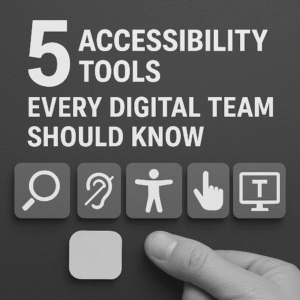The importance of making your e-commerce website accessible to all users, especially those with disabilities, is not only a requirement in many places but also a smart business practice. This post will look into important parts of testing accessibility for e-commerce sites such as the methods, tools, and strategies used.
Overview of Accessibility Testing Methods
Accessibility testing can be broadly categorized into two approaches:
1. Manual Testing:
- Involves human testers navigating the website using assistive technologies
- Allows for nuanced evaluation of user experience
- Can uncover issues that automated tools might miss
- Time-consuming and potentially subjective
2. Automated Testing:
- Uses software tools to scan websites for accessibility issues
- Can quickly check large numbers of pages
- Provides consistent results
- May miss context-dependent problems
For comprehensive accessibility testing, a combination of both methods is recommended.
Read More On Accessible Design Elements in E-commerce
Tools and Technologies for Testing
Several tools can assist in accessibility testing:
1. Web Accessibility Evaluation Tools:
- WAVE (Web Accessibility Evaluation Tool)
- aXe
- Lighthouse (integrated into Chrome DevTools)
2. Screen Readers:
- NVDA (NonVisual Desktop Access)
- JAWS (Job Access With Speech)
- VoiceOver (for macOS and iOS)
3. Color Contrast Analyzers:
- WebAIM Color Contrast Checker
- Colour Contrast Analyser
4. Browser Extensions:
- WAVE Evaluation Tool
- Accessibility Insights for Web
5. Keyboard Navigation Tools:
- Most modern browsers support keyboard navigation natively
Read More on E-commerce Accessibility: Ensuring Equal Opportunities Online
Creating an Effective Testing Strategy
To develop a robust accessibility testing strategy for your e-commerce site:
1. Define Scope: Select and put in order the most important user journeys like finding a product or going through the process of checking out.
2. Set Standards: Decide which accessibility guidelines to follow (e.g., WCAG 2.1 AA).
3. Combine Methods: Use both automated and manual testing for comprehensive coverage.
4. Involve Users: Include people with disabilities in your testing process for real-world insights.
5. Regular Testing: Implement accessibility testing as part of your regular development and QA processes.
6. Train Your Team: Ensure developers and content creators understand accessibility principles.
7. Address Issues: Prioritize and fix identified accessibility problems.
8. Monitor and Iterate: Continuously assess your site’s accessibility and make improvements.
You could use an accessibility testing plan to make sure that your e-commerce website gives equal shopping opportunities for every user. This might stop you from legal problems and also help in expanding the number of customers.
Read More On the Benefits of Accessible E-commerce Websites



